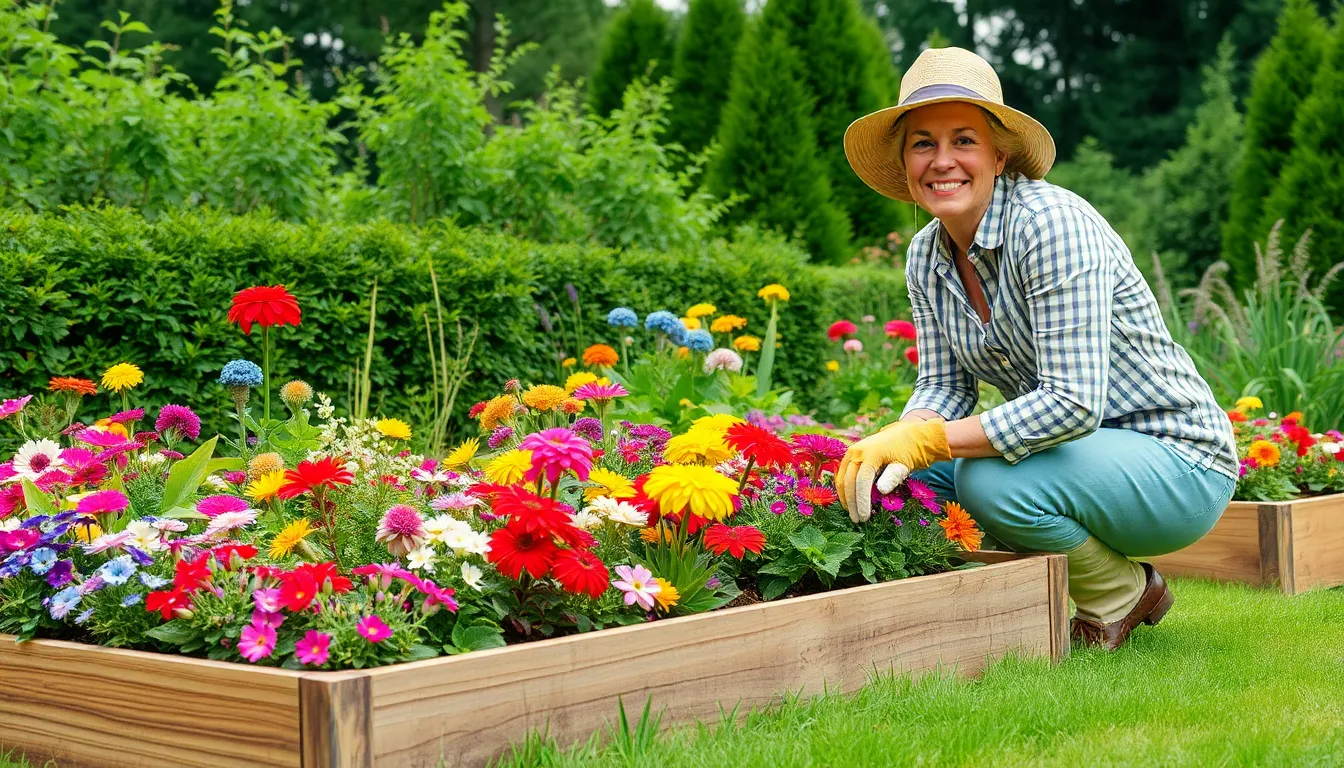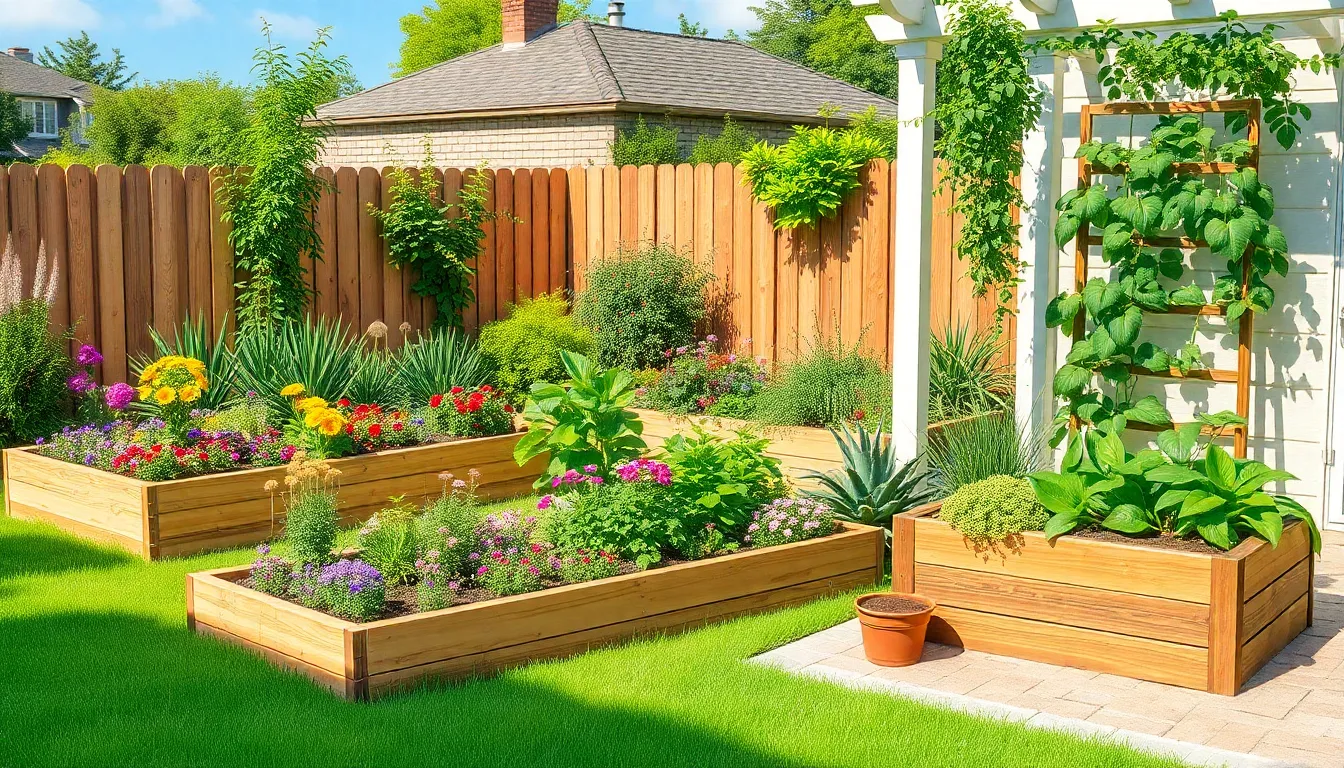Phone:
(701)814-6992
Physical address:
6296 Donnelly Plaza
Ratkeville, Bahamas.

Creating the perfect garden bed isn’t just about throwing some seeds in the dirt and hoping for the best. It’s an art form that combines creativity, practicality, and a sprinkle of patience. Whether you’re a seasoned gardener or just starting out, the right design can turn a patch of soil into a flourishing oasis that even your neighbor’s prize-winning petunias will envy.
Garden bed design plays a crucial role in transforming outdoor spaces. Thoughtful design impacts both functionality and visual appeal.
Garden beds significantly contribute to the overall beauty of a landscape. Colorful plants and flowers create focal points in the garden, attracting attention. Various designs, such as raised beds or geometric shapes, add depth and dimension. Diverse plant species can enhance texture and visual interest. Incorporate elements like decorative edging or unique materials to create defined boundaries and elevate the garden’s look. An eye-catching design not only enriches personal enjoyment but also increases property value.
Efficient garden bed design optimizes available space for growing plants. Utilizing vertical gardening techniques enables the cultivation of more plants in smaller areas. Arranging plants based on height and spread promotes better sunlight exposure and air circulation. Companion planting encourages synergy among plants, enhancing growth and yield. Incorporating pathways facilitates access for maintenance without disturbing soil or plants. Space-efficient layouts can lead to higher productivity, especially in urban gardening scenarios where space constraints exist.

Various garden bed types cater to different gardening needs and preferences. Understanding these designs helps gardeners maximize aesthetics and functionality.
Raised beds elevate soil above ground level, offering improved drainage. These structures can be constructed from wood, stone, or metal, providing flexibility in style. They warm up quicker in spring, allowing for earlier planting. Soil quality stays controlled, making it easier to manage pests and weeds. Many gardeners appreciate raised beds for their ergonomic design, which reduces bending and kneeling.
In-ground beds feature traditional planting directly in the soil, making them easy to establish. These beds utilize existing soil, allowing for natural plant growth. Gardeners often amend the soil based on plant needs, enhancing nutrient availability. Crop rotation and companion planting thrive in these beds. They suit larger-scale gardening and can support diverse plant varieties.
Vertical garden beds optimize space by utilizing vertical structures for planting. These beds can include wall planters, towers, and trellises, showcasing creativity in design. Space-saving techniques promote airflow and sunlight exposure, leading to healthier plants. Vertical gardening allows growing in compact areas like balconies and patios. These beds combine aesthetics and functionality while minimizing ground space requirements.
Choosing the right materials for garden bed construction enhances both durability and aesthetics. Various options suit different gardening needs.
Cedar and redwood are popular for their natural resistance to rot and pests. Pressure-treated lumber offers another option, though caution is key due to potential chemical leaching. A typical lifespan for untreated wood lasts around three to seven years. Many gardeners prefer using untreated materials for organic gardens, prioritizing safety over longevity. Reclaimed wood options allow for creativity and sustainability while adding rustic charm to outdoor spaces.
Galvanized steel and aluminum stand out in the metal category due to their strength and resistance to rust. Galvanized steel has a long lifespan, often lasting over ten years. Aluminum is lightweight and offers easy handling, making it suitable for various designs. Metal beds provide a modern aesthetic and retain heat, promoting plant growth in cooler climates. However, gardeners should consider using insulation when planting heat-sensitive species.
Concrete blocks and bricks offer sturdy alternatives, creating a fortress-like structure for garden beds. These materials can last for decades and withstand various weather conditions. Additionally, they allow for creative configurations. Eco-friendly options include recycled plastic lumber or even straw bales, which provide insulation and support for growing vegetables. Each alternative material contributes distinct features and can align with personal garden styles.
Planning a garden bed design involves evaluating space and selecting suitable plants. Thoughtful decisions create an appealing and functional garden.
Evaluate available sunlight in the selected area. Observe how sunlight shifts throughout the day to identify optimal planting zones. Assess soil quality, noting texture and composition. Test drainage capabilities, as poor drainage may hinder plant health. Factor in proximity to water sources, ensuring convenient access for irrigation. Acknowledge existing landscape features; nearby trees or structures may affect growth conditions. Map out dimensions for the garden bed to maximize usable area while maintaining accessibility. Consider using garden plans or design software to visualize layouts. Each of these aspects influences overall garden success.
Select plants based on growing conditions and garden style. Consider local climate zones to ensure plant survival and growth. Choose a mix of perennial and annual options, providing year-round interest. Prioritize companion planting, which fosters mutual benefits among plants. Opt for plants that thrive in similar moisture and sunlight requirements to simplify care. Categories, such as flowering herbs or vegetables, enhance both aesthetics and utility. Incorporate native plants to support local ecosystems and attract beneficial wildlife. Each choice empowers the garden’s overall theme and function, creating a vibrant outdoor space.
Maintaining garden beds enhances both their health and appearance. Regular attention ensures vibrant plants and fruitful yields.
Watering regularly helps keep plants hydrated. Checking soil moisture levels prevents over or under-watering. Mulching conserves moisture while suppressing weeds. Fertilizing with balanced nutrients promotes strong growth. Observing plants for pests and diseases allows for early intervention. Pruning dead or faded foliage encourages new growth and improves aesthetics. Regularly rotating crops in beds helps maintain soil health and prevent nutrient depletion.
Spring preparation includes cleaning debris and refreshing mulch. During summer, monitoring moisture levels becomes crucial, especially in heat. Fall tasks involve pruning perennial plants and removing spent annuals. Winter maintenance requires protecting plants from harsh weather with coverings or insulation. Testing soil in early spring aids in understanding nutrient needs for optimal growth. Scheduling light tilling or turning of soil in the fall improves aeration and soil quality.
Creating a stunning garden bed goes beyond simply planting seeds. It’s about combining creativity with practicality to cultivate a thriving outdoor space. By thoughtfully designing each element from materials to plant selection, gardeners can enhance both beauty and functionality.
Whether opting for raised beds or vertical gardens, the choices made can significantly impact the overall gardening experience. Regular maintenance ensures that these vibrant spaces remain healthy and productive throughout the seasons.
Ultimately, a well-designed garden bed not only reflects personal style but also contributes to a more enjoyable and fruitful gardening journey. Embracing the art of garden bed design can lead to a landscape that’s not only visually appealing but also a source of pride and satisfaction.